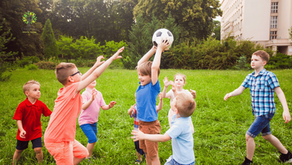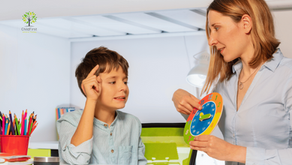Playful Learning Through Educational Indoor Activities for Autism
- ChildFirst Behavior Therapy

- Dec 19, 2023
- 6 min read
Updated: Dec 30, 2023

Children with autism benefit from structured settings tailored to their learning needs. Engaging them in playful learning, crucial for children's ABA therapy, aids cognitive, social, and emotional growth. This article delves into the importance of playful learning in autism, offering a guide to indoor educational activities nurturing holistic development.
The Benefits of Indoor Activities for Autism
Indoor activities serves a powerful tool for children with autism due to several key advantages:
Engagement and Interaction: Play-based activities capture the child's interest, encouraging active participation and interaction with peers and caregivers.
Skill Development: These activities enhance communication, fine and gross motor skills, cognitive abilities, and emotional regulation.
Stimulation and Calming Activities: Many children with autism have specific sensitivities. Playful learning activities can be adjusted to offer calming and beneficial experiences that cater to individual preferences and comfort.
Emotional Expression: Play-based learning creates a safe space for children to express their emotions, fostering emotional development and self-regulation.
Educational Indoor Activities for Playful Learning
Exploratory Play: Make bins filled with materials such as rice, beans, or sand, including a variety of textures and objects for hands-on exploration. This activity enhances tactile experiences.
Pretend Play and Social Skills: Role-playing games, such as playing house or acting out familiar scenarios, help develop social skills, empathy, and understanding of social interactions.
Visual Supports and Structured Activities: Visual schedules, picture cards, and structured activities like sorting colors or shapes provide predictability and help organize thoughts and actions.
Arts and Crafts: Engaging in art activities like painting, drawing, or crafting allows children to express themselves creatively while improving fine motor skills.
Interactive Technology: Utilize educational apps or computer programs specifically designed for children with autism to enhance learning in a fun and interactive way.
Storytelling and Narrative Building: Encourage storytelling or use visual aids like storyboards to help children structure and express their thoughts coherently.
Music and Movement: Incorporate music and movement activities such as dancing, singing, or playing musical instruments to encourage self-expression and regulation.
Implementing Playful Learning at Home and in Educational Settings
Implementing playful learning activities requires a personalized approach considering each child's strengths, preferences, and challenges. Whether at home or in educational settings, a few strategies can enhance the effectiveness of these activities:
Individualized Approach: Customize activities to match the child's interests, skills, and individual preferences.
Consistency and Structure: Establish a routine and provide clear expectations to create a structured environment conducive to learning.
Positive Reinforcement: Use positive reinforcement techniques, such as praise or rewards, to encourage participation and effort.
Flexibility and Patience: Be flexible and patient, allowing the child to progress at their own pace without pressure.
Types of Educational Indoor Activities

Organized Activities for Stimulation: Tailoring experiences can aid kids with autism in managing their input. For instance, activities such as crafting boards with diverse textures (soft, rough, smooth) or arranging rooms with calming lights, weighted blankets, and toys establish controlled spaces for exploration and relaxation.
Game-Based Learning: Incorporating board games or specially designed educational games can enhance skills such as turn-taking, sharing, following rules, and problem-solving. Games like puzzles, matching, or memory games can be adapted to match the child's developmental level.
Building and Construction Play: Building blocks, Lego sets, or other construction toys encourage creativity, spatial reasoning, and fine motor skills. Guided building tasks or creating specific structures can enhance focus and attention to detail.
Cooking and Food Exploration: Engaging children in basic cooking activities offers a varied experience involving multiple senses. It promotes independence, following instructions, and understanding sequences while exploring different tastes and textures.
Nature Discovery and Exploration: Engaging with nature, even indoors, through gardening, planting seeds, or creating indoor terrariums introduces children to the natural world, fostering a sense of wonder and exploration.
Social Stories and Role-Playing: Utilizing social stories helps children understand social cues and navigate social situations better. Role-playing scenarios, like practicing greetings or dealing with everyday situations, provide a safe environment for learning social skills.
Technology-Assisted Learning: Accessing educational software, interactive learning apps, or programs designed for kids with autism can provide personalized learning experiences while incorporating technology into their education.
Adaptive Physical Activities: Adjusting physical activities like yoga, dance, or stretching exercises to fit specific needs and overcome motor challenges supports physical well-being while enhancing body awareness and coordination. These activities can be implemented in various settings, including home, school, or therapy sessions, ensuring a holistic approach to a child's developmental journey.
In addition to activity-based learning, it's essential to consider the role of caregivers, educators, and therapists in facilitating these activities:
Caregiver Involvement: Encouraging caregivers to participate in these activities actively creates a supportive environment for the child. Caregivers can learn techniques from therapists or educators and continue implementing them at home.
Educator Training and Collaboration: Educators benefit from specialized training in techniques and strategies for teaching kids with autism. Collaborating with therapists and caregivers ensures consistency and reinforces learning across different environments.
Individualized Education Plans (IEPs): Developing personalized education plans allows educators and therapists to cater to each child's specific needs, strengths, and challenges, ensuring a tailored approach to their learning and development.
Parent Support Networks: Creating networks or support groups for parents of kids with autism fosters information sharing, emotional support, and the exchange of practical strategies for dealing with daily challenges.

Creating an Inclusive Environment: Promoting acceptance and understanding among peers and creating inclusive environments in schools and communities helps children with autism feel valued and accepted, enhancing their social experiences.
Conclusion
In conclusion, playful learning through tailored indoor activities is a cornerstone in the holistic development of children with autism. These activities serve as educational tools and platforms for social interaction and emotional expression. By weaving diverse activities into daily routines and fostering collaboration between caregivers, educators, and therapists, we create an environment that nurtures the unique needs of children with autism, enabling them to thrive in various aspects of life.
If you're seeking specialized guidance or support in implementing these strategies, contact ChildFirst Behavior Therapy. Our team is dedicated to providing personalized assistance and resources for children with autism. Contact us at ChildFirst Behavior Therapy to learn how we can assist your child's developmental journey. Remember, by embracing playful learning and working together, we can create an inclusive and supportive environment where every child has the opportunity to flourish.
FAQs
How do I determine which activities are suitable for my child with autism?
Customizing activities to fit your child's interests, preferences, and developmental stage is vital. Begin with things they like and slowly introduce new ones, observing how they react and making adjustments as needed.
What if my child shows resistance to certain activities?
Children with autism often have sensitivities or aversions. If an activity is difficult, consider adjusting it by changing the input or breaking it into smaller, more manageable steps. Gradually introducing and positively reinforcing these steps can help overcome resistance.
How can I incorporate these activities into my child's daily routine?
Establishing a consistent schedule with designated times for activities can create predictability. Introduce activities when your child is most receptive and consider incorporating them into transitions or as part of a reward system.
What role do caregivers play in supporting these activities?
Caregivers play a pivotal role in facilitating and participating in activities. They can observe, support, and reinforce learning by providing encouragement, assistance, and guidance as needed.
Are there resources or communities available for parents/caregivers of kids with autism?
Numerous resources, support groups, and online communities offer guidance, information, and a platform for sharing experiences. Organizations like ChildFirst Behavior Therapy often provide resources and advice tailored to the needs of children with autism.
Can these activities be integrated into school settings or therapy sessions?
Absolutely. Many of these activities are adaptable and can be incorporated into school curriculums or therapy sessions. Collaborating with educators and therapists ensures a consistent approach across various environments.
How can I measure the progress or effectiveness of these activities?
Observing your child's engagement, communication, and skill development over time can help gauge progress. Tracking changes in behavior, communication, and social interactions can provide insights into the effectiveness of the activities.
What if my child has specific challenges or needs that require specialized activities?
Seeking guidance from professionals, such as behavior or occupational therapists specializing in autism, can help identify and implement activities tailored to address specific challenges or needs.
How do I maintain motivation and engagement in these activities over time?
Rotating activities, introducing novelty, incorporating rewards, and ensuring a supportive and encouraging environment can help maintain motivation and engagement.
Where can I find additional resources or information on playful learning for autism?
Websites of autism-focused organizations, educational platforms, and professional therapy services often offer detailed information, activity ideas, and resources specific to playful learning for children with autism.
How can I adapt activities to suit my child's unique needs or skill level?
Modifying activities requires understanding your child's strengths and challenges. Think about simplifying tasks, offering extra visual aids, altering the pace, or adding elements that cater to your child's preferences, making activities more accessible and enjoyable.










Comments